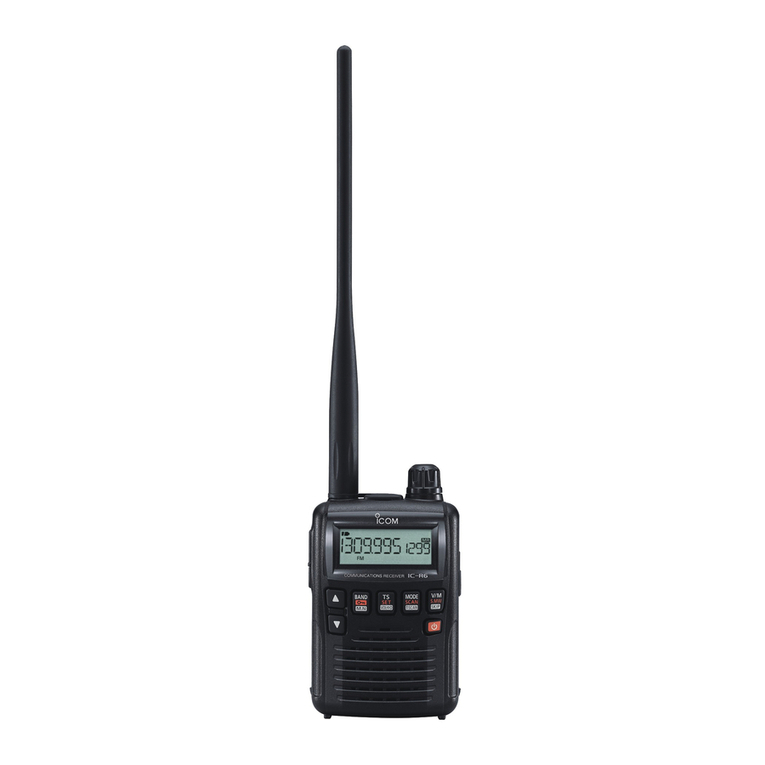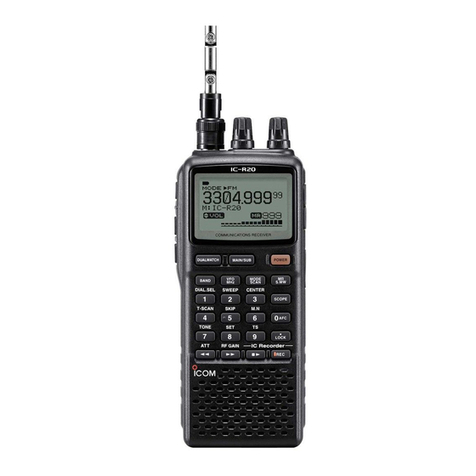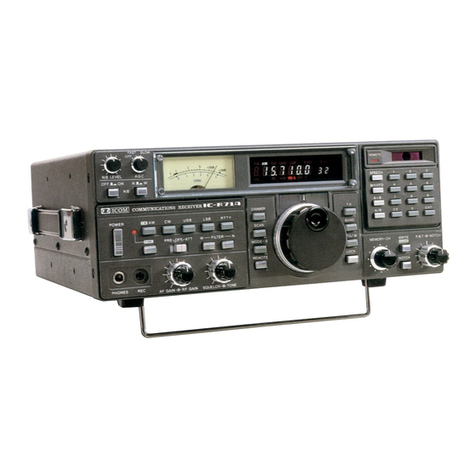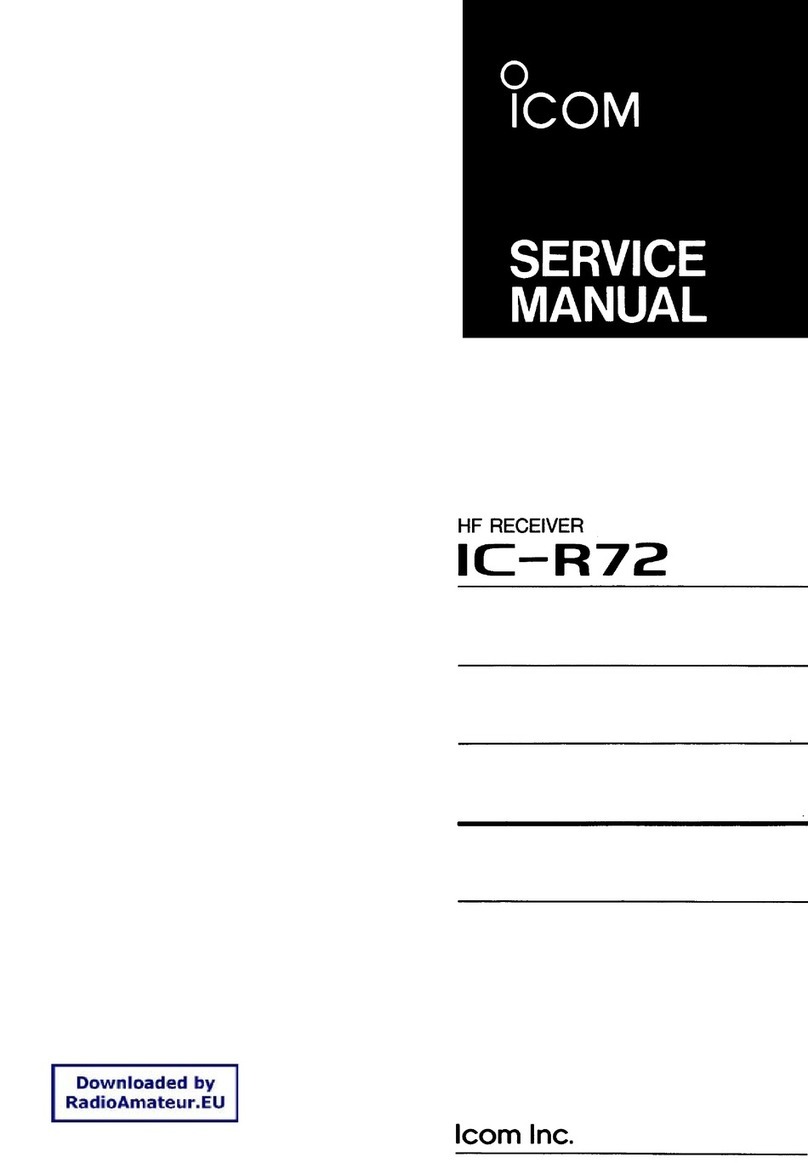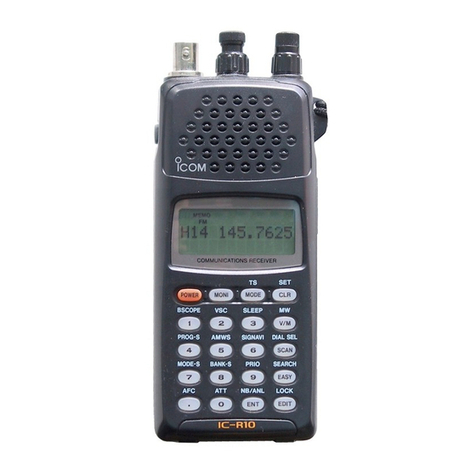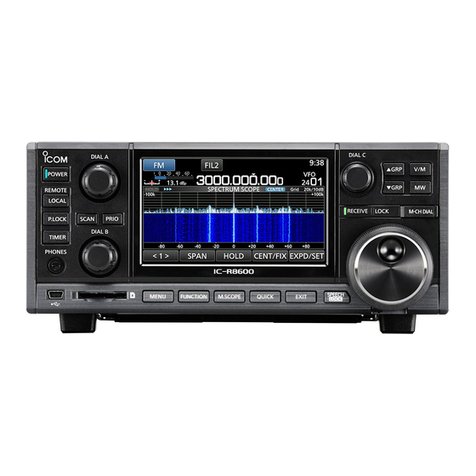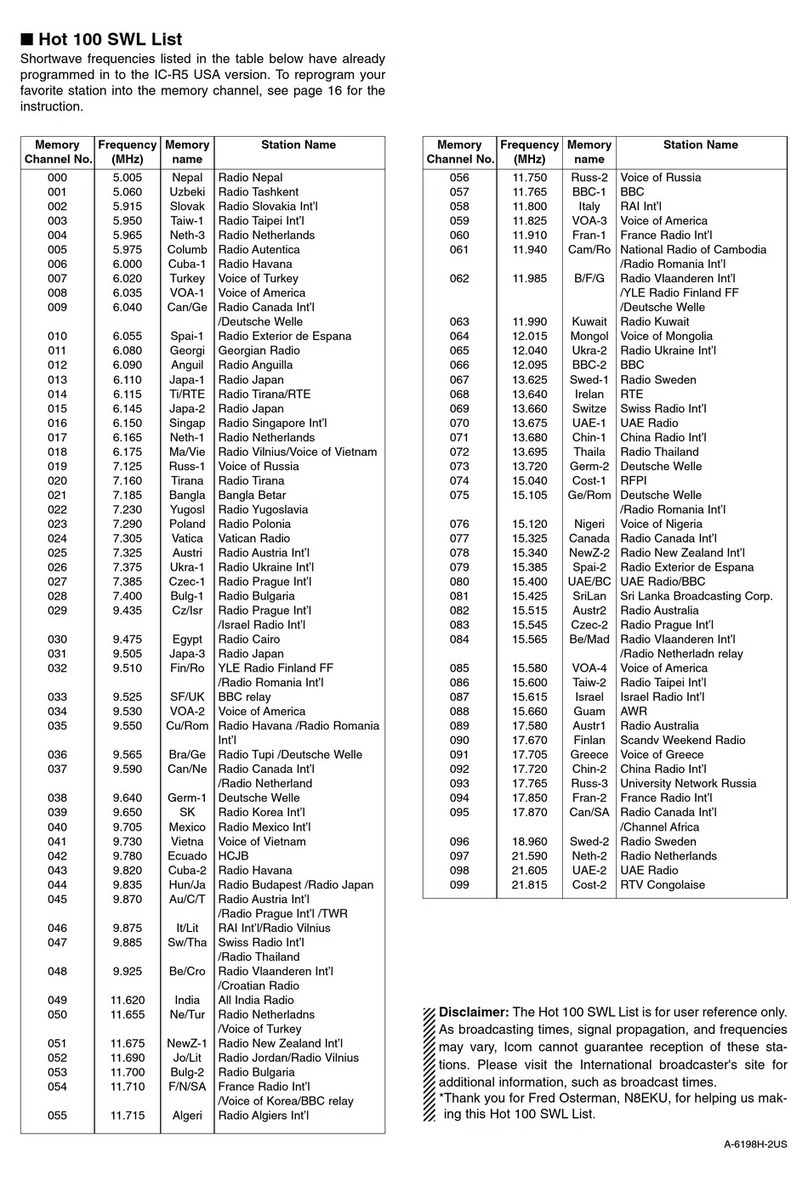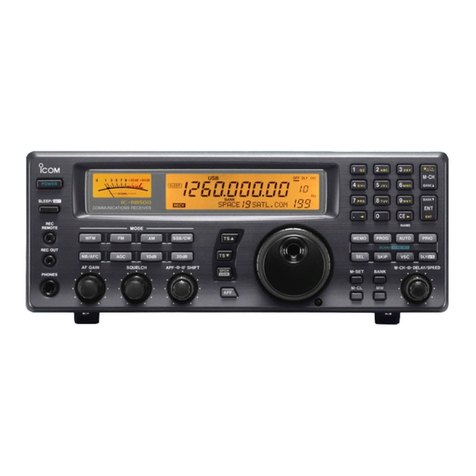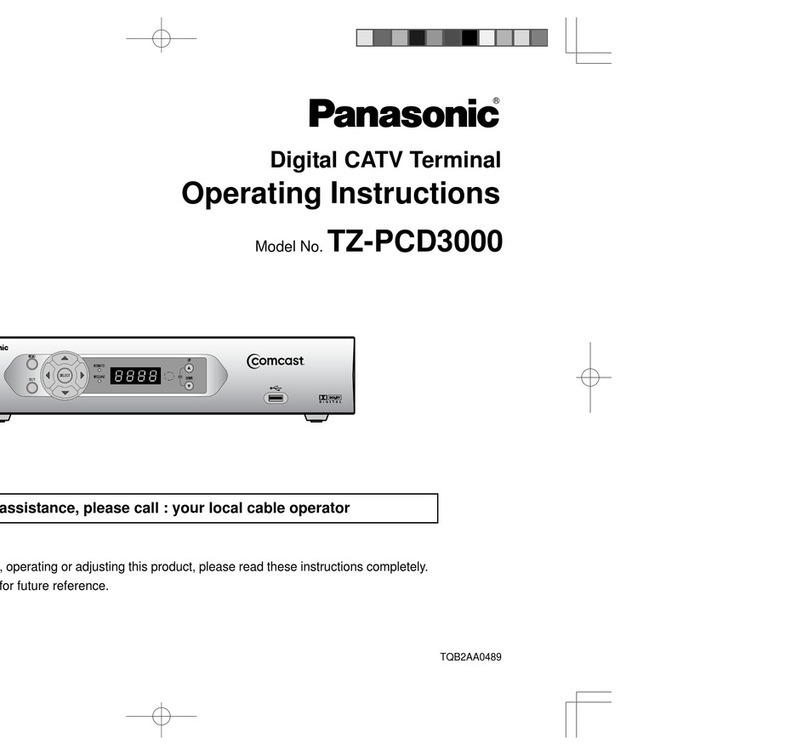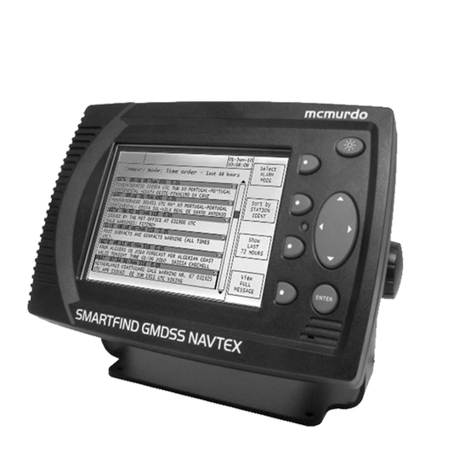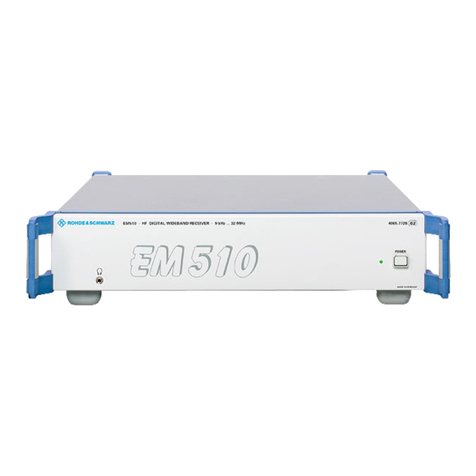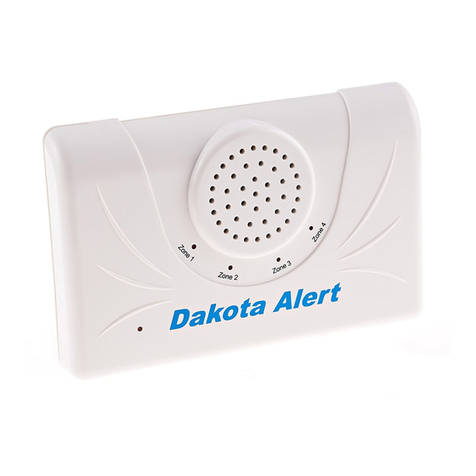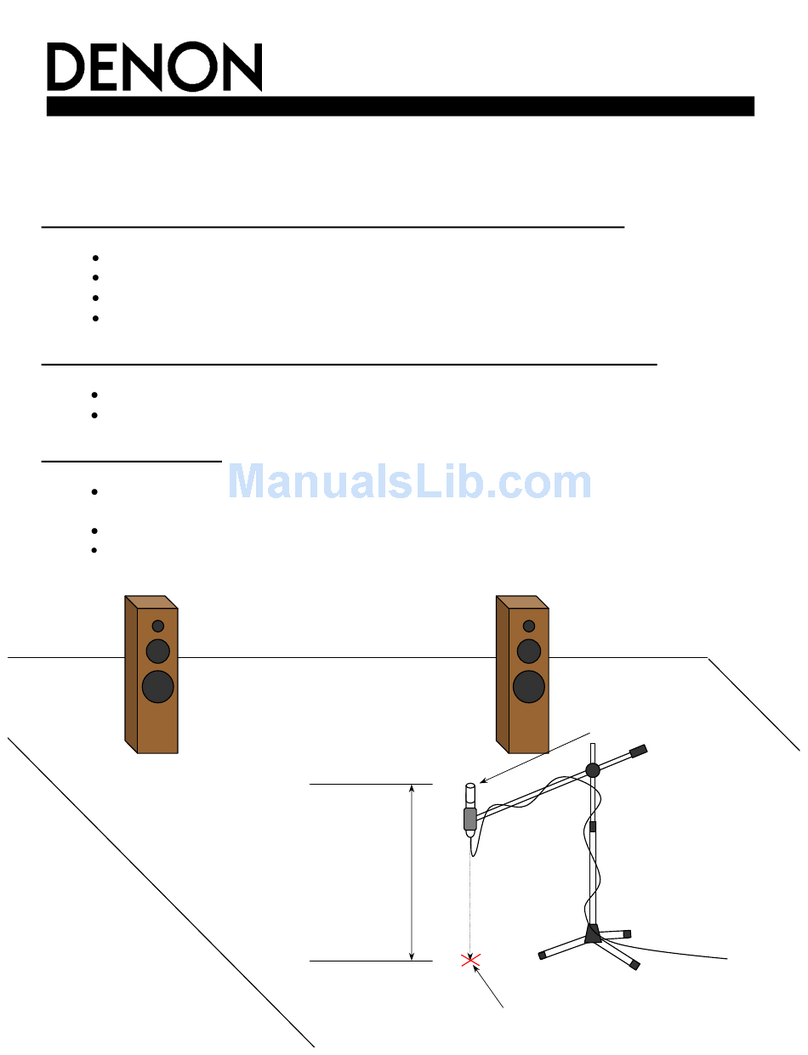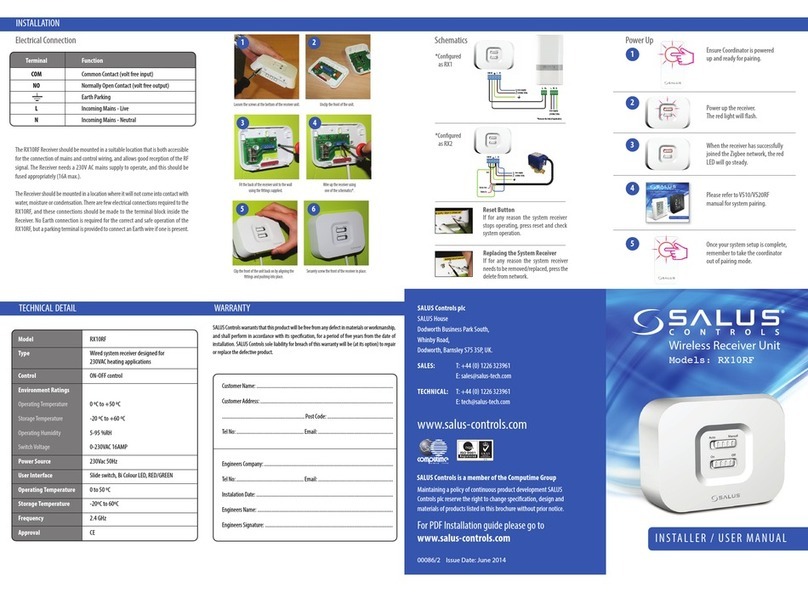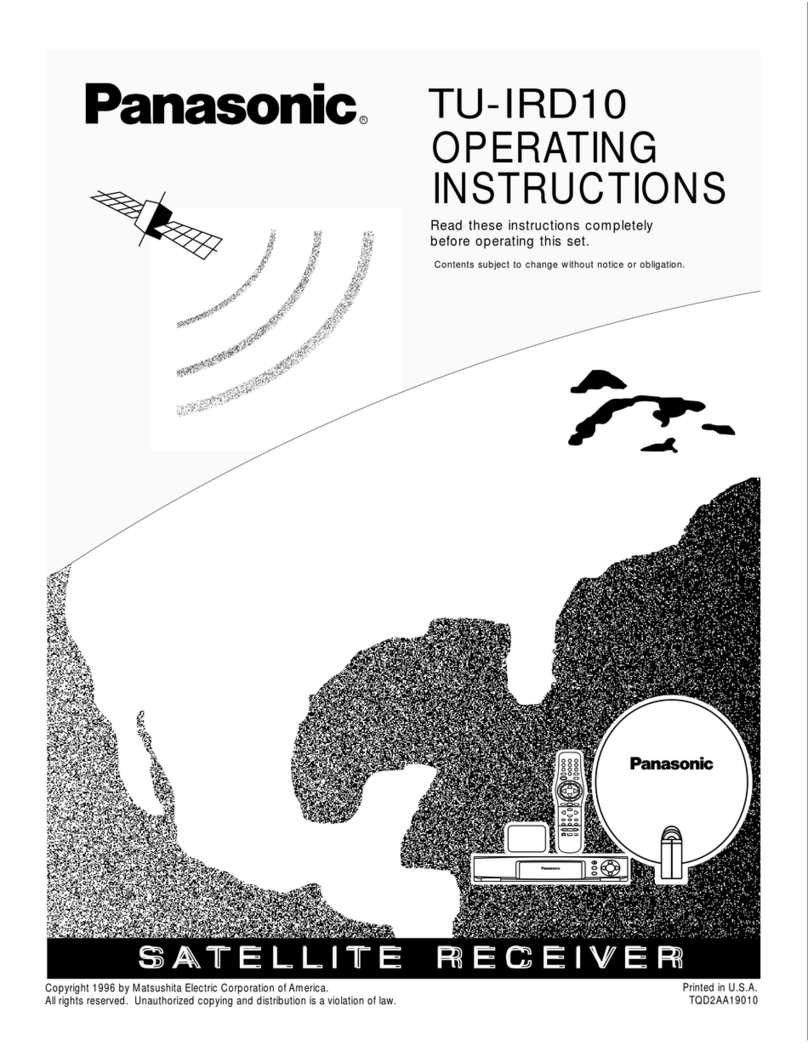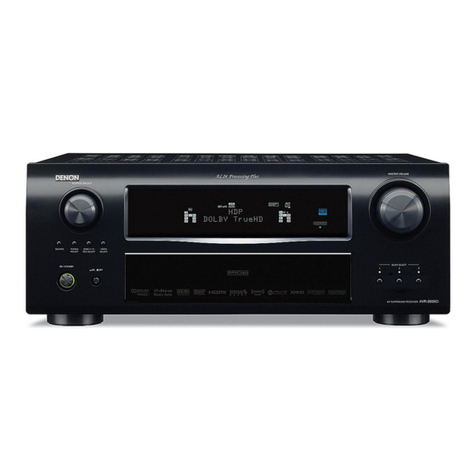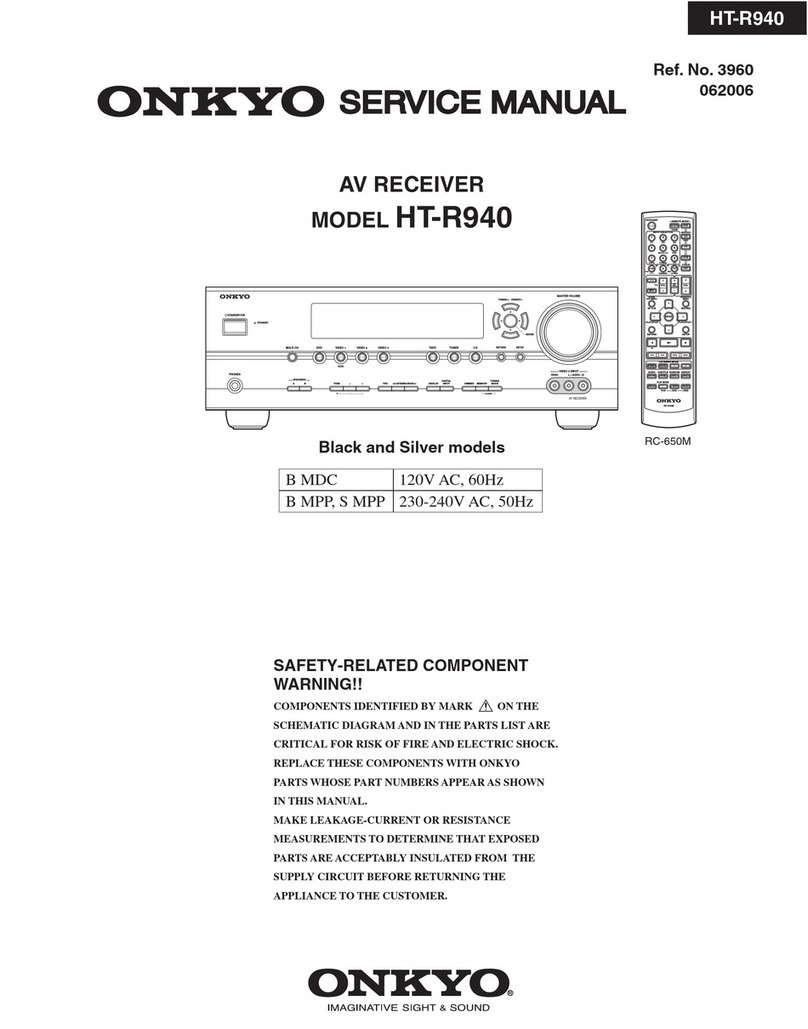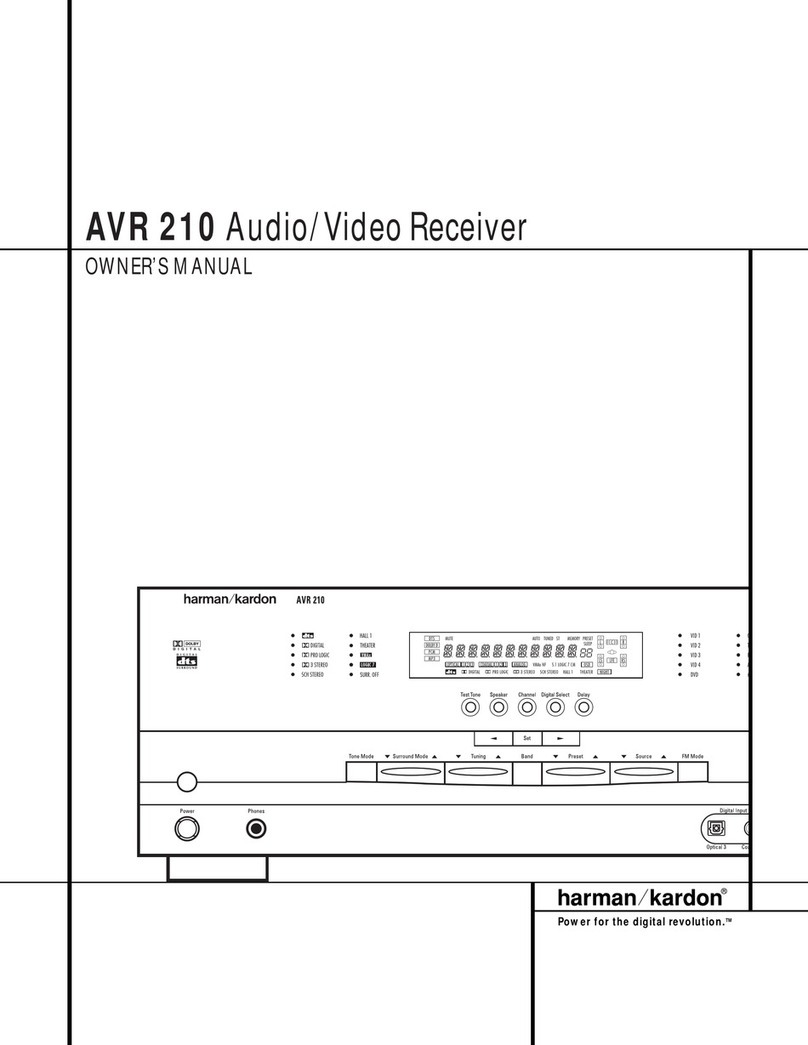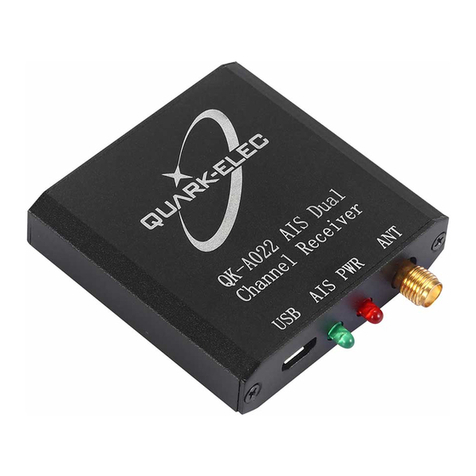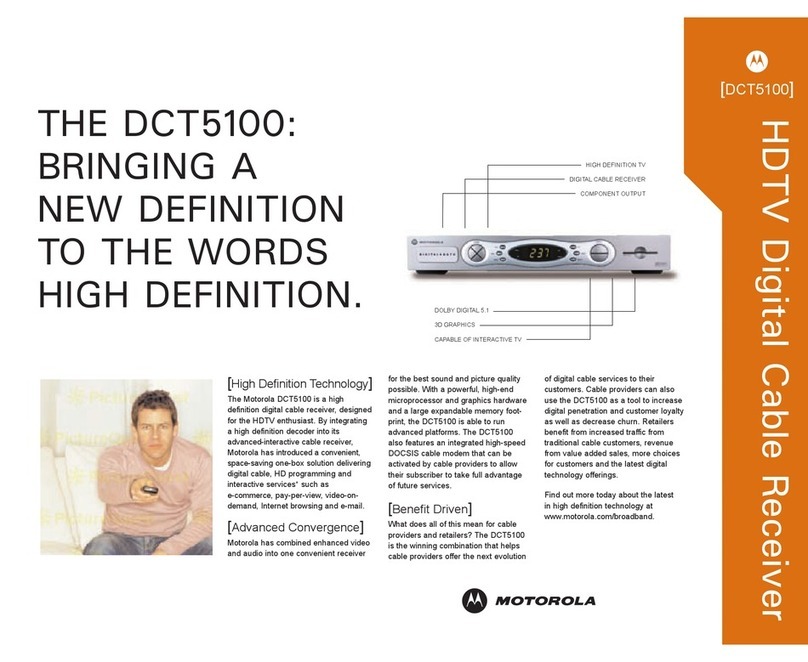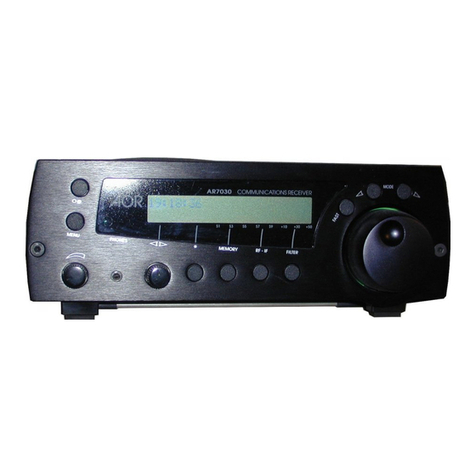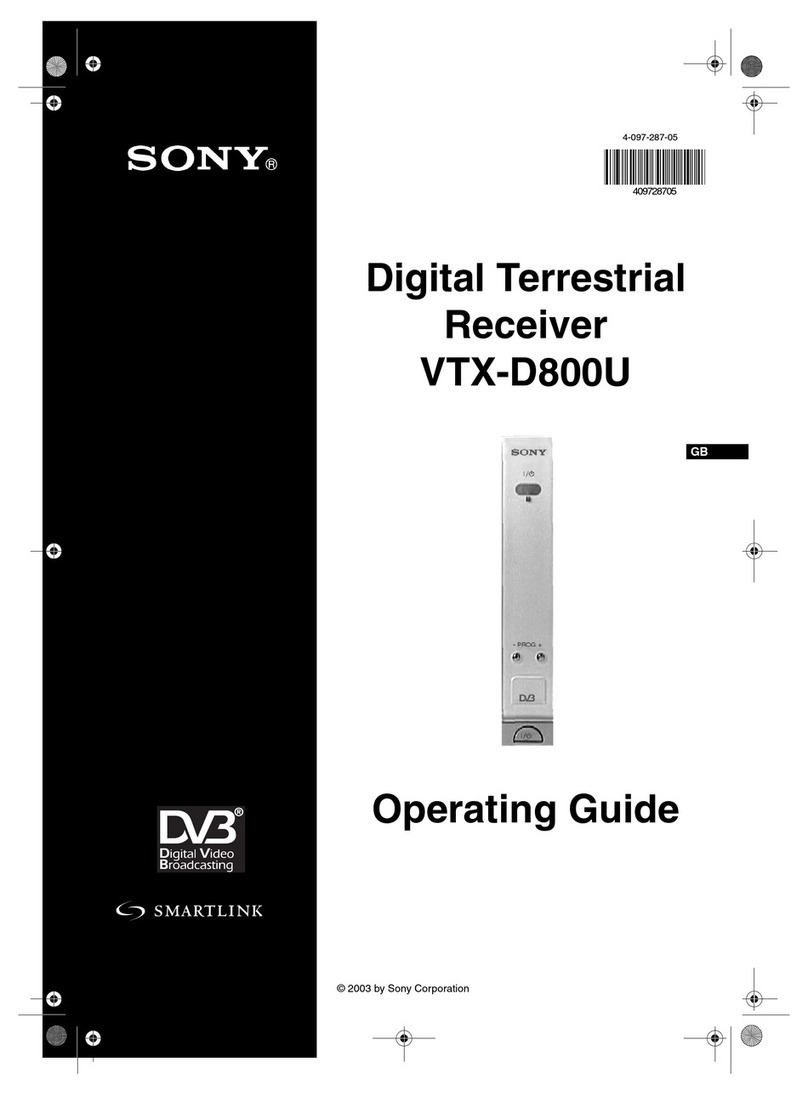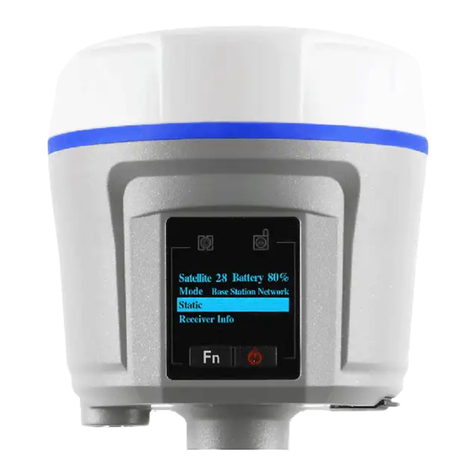Icom IC-RX7 User manual

This device complies with Part 15 of the FCC Rules. Operation
is subject to the following two conditions: (1) this device may
not cause harmful interference, and (2) this device must accept
any interference received, including interference that may cause
undesired operation.
WARNING: MODIFICATION OF THIS DEVICE TO RECEIVE CEL-
LULAR RADIOTELEPHONE SERVICE SIGNALS IS PROHIBITED
UNDER FCC RULES AND FEDERAL LAW.
INSTRUCTION MANUAL
New2001
iRX7
WIDEBAND RECEIVER

i
New2001 New2001
FOREWORD
Thank you for purchasing this Icom product. The IC-RX7
wideband receiver is designed and built with Icom’s superior
technology and craftsmanship. With proper care, this product
should provide you with years of trouble-free operation.
We want to take a couple of moments of your time to thank
you for making your IC-RX7 your radio of choice, and hope you
agree with Icom’s philosophy of “technology first.” Many hours
of research and development went into the design of your
IC-RX7.
FEATURES
❍Covers 0.150–1300 MHz* wide frequency
range
* Some frequency bands are inhibited according to ver-
sion
❍Splash-resistance construction (IPX4)
Only when supplied antenna, battery pack and cap are
attached.
❍External power supply operation
❍1600 memory channels with 26 categories
are available
❍Optional PC programming
IMPORTANT
READ ALL INSTRUCTIONS carefully and completely
before using the receiver.
SAVE THIS INSTRUCTION MANUAL— This in-
struction manual contains important operating instructions
for the IC-RX7.
EXPLICIT DEFINITIONS
Versions of the IC-RX7 which display the “CE” symbol on
the serial number seal, comply with the essential require-
ments of the European Radio and Telecommunication Ter-
minal Directive 1999/5/EC, and that any applicable Essen-
tial Test Suite measurements have been performed.
WORD DEFINITION
RWARNING!
CAUTION
NOTE
Personal injury, fire hazard or electric
shock may occur.
Equipment damage may occur.
Recommended for optimum use. No risk of
personal injury, fire or electric shock.

New2001
ii
RWARNING! NEVER operate the receiver with an
earphone, headphones or other audio accessories at high
volume levels. Hearing experts advise against continuous
high volume operation. If you experience a ringing in your
ears, reduce the volume level or discontinue use.
RWARNING! NEVER operate the receiver while
driving a vehicle. Safe driving requires your full attention—
anything less may result in an accident.
RWARNING! NEVER connect the receiver directly
to an AC outlet. This may pose a fire hazard or result in an
electric shock.
RWARNING! NEVER connect the receiver directly
to a power source of more than 6.9 V DC. This will ruin the
receiver.
RWARNING! NEVER connect the receiver to a
power source using reverse polarity. This will ruin the re-
ceiver.
DO NOT use or place the receiver in direct sunlight or
in areas with temperatures below –10°C (+14˚F) or above
+60°C (+140˚F).
Place the unit in a secure place to avoid inadvertent use by
children.
DO NOT use of chemical agents such as benzene or
alcohol when cleaning, as they can damage the receiver’s
surfaces.
NEVER expose the receiver to rain, snow or any liquids.
The receiver may be damaged.
NEVER operate or touch the receiver with wet hands.This
may result in an electric shock or damage the receiver.
Even when the receiver power is OFF, a slight current still
flows in the circuits. Remove the battery pack or batteries
from the receiver while not using it for a long time. Other-
wise, the installed battery pack or batteries will become ex-
hausted, and will need to be recharged or replaced.
RESPECT other people’s privacy. Information overheard
but not intended for you cannot lawfully be used in any way.
For U.S.A. only
CAUTION!: Changes or modifications to this device, not
expressly approved by Icom Inc., could void your authority to
operate this device under FCC regulations.
PRECAUTIONS

iii
New2001 New2001
FCC INFORMATION
• FOR CLASS B UNINTENTIONAL RADIATORS:
This equipment has been tested and found to comply with
the limits for a Class B digital device, pursuant to part 15 of
the FCC Rules.These limits are designed to provide reason-
able protection against harmful interference in a residential
installation. This equipment generates, uses and can radi-
ate radio frequency energy and, if not installed and used
in accordance with the instructions, may cause harmful
interference to radio communications. However, there is no
guarantee that interference will not occur in a particular in-
stallation. If this equipment does cause harmful interference
to radio or television reception, which can be determined by
turning the equipment off and on, the user is encouraged to
try to correct the interference by one or more of the following
measures:
• Reorient or relocate the receiving antenna.
• Increase the separation between the equipment and re-
ceiver.
• Connect the equipment into an outlet on a circuit differ-
ent from that to which the receiver is connected.
• Consult the dealer or an experienced radio/TV techni-
cian for help.
SUPPLIED ACCESSORIES
The following accessories are supplied with the receiver.
qHand strap ��������������������������������������������������������������������� 1
wAntenna �������������������������������������������������������������������������� 1
eBelt clip ���������������������������������������������������������������������������1
rBattery pack* (BP-244) �������������������������������������������������� 1
tBattery charger* (BC-149A/D) ��������������������������������������� 1
(The shape of the BC-149A and BC-149D are different.)
*Not supplied with some versions.
t
e
q
r
w

New2001
iv
Icom, Icom Inc. and the logo are registered trademarks of Icom
Incorporated (Japan) in the United States, the United Kingdom,
Germany, France, Spain, Russia and/or other countries.
Microsoft, Windows and Windows Vista are either registered trade-
marks or trademarks of Microsoft Corporation in the United States
and/or other countries.
OPERATING THEORY
Electromagnetic radiation which has frequencies of
20,000 Hz (20 kHz*) and above is called radio frequency
(RF) energy because it is useful in radio transmissions. The
IC-RX7 receives RF energy from 0.150 MHz* to 1300 MHz
and converts it into audio frequency (AF) energy which in
turn actuates a loudspeaker to create sound waves. AF en-
ergy is in the range of 20 to 20,000 Hz.
*kHz is an abbreviation of kilohertz or 1000 hertz, MHz is abbrevia-
tion of megahertz or 1,000,000 hertz, where hertz is a unit of fre-
quency.
OPERATING NOTES
The IC-RX7 may receive its own oscillated frequency, result-
ing in no reception or only noise reception, on some fre-
quencies.
The IC-RX7 may receive interference from extremely strong
signals on different frequencies or when using an external
high-gain antenna.

New2001
vi
New2001
FOREWORD�������������������������������������������������������������������������������������i
FEATURES����������������������������������������������������������������������������������������i
IMPORTANT��������������������������������������������������������������������������������������i
EXPLICIT DEFINITIONS�������������������������������������������������������������������i
PRECAUTIONS�������������������������������������������������������������������������������� ii
FCC INFORMATION ����������������������������������������������������������������������� iii
SUPPLIED ACCESSORIES������������������������������������������������������������ iii
OPERATING THEORY�������������������������������������������������������������������� iv
OPERATING NOTES�����������������������������������������������������������������������iv
TABLE OF CONTENTS ��������������������������������������������������������������v–vii
1 ACCESSORY ATTACHMENT·····················································1
■Antenna �����������������������������������������������������������������������������������1
■Belt clip������������������������������������������������������������������������������������1
■Hand strap�������������������������������������������������������������������������������2
■Battery installation �������������������������������������������������������������������2
■Optional battery case���������������������������������������������������������������3
2 PANEL DESCRIPTION···························································4–9
■Front, top and side panels �������������������������������������������������������4
■Function display�����������������������������������������������������������������������7
3 BATTERY CHARGING ·······················································10–13
■Caution ����������������������������������������������������������������������������������10
■Charging��������������������������������������������������������������������������������12
■Battery information ����������������������������������������������������������������13
■External DC power operation�������������������������������������������������13
4 BASIC OPERATION ···························································14–19
■Power ON ������������������������������������������������������������������������������14
■Setting audio volume�������������������������������������������������������������14
■Setting squelch level��������������������������������������������������������������15
■Monitor function���������������������������������������������������������������������15
■Operating mode selection������������������������������������������������������16
■Receiving mode selection������������������������������������������������������19
5 FREQUENCY SETTING ·····················································20–23
■Setting a frequency����������������������������������������������������������������20
■Setting a tuning step��������������������������������������������������������������23
6 SEARCH AND SCAN OPERATIONS·································24–46
■Search and scan types����������������������������������������������������������24
■Full search ����������������������������������������������������������������������������26
■Basic search �������������������������������������������������������������������������26
■Band search ��������������������������������������������������������������������������27
■Program search ��������������������������������������������������������������������28
■Program link search���������������������������������������������������������������29
■Search edges programming �������������������������������������������������30
■Program link programming ���������������������������������������������������32
■Auto write search ������������������������������������������������������������������34
■Skip search ���������������������������������������������������������������������������36
■Priority watch during search �������������������������������������������������37
■Other SEARCH menu items �������������������������������������������������38
■Link scan ������������������������������������������������������������������������������39
■All scan ����������������������������������������������������������������������������40
■Category scan ���������������������������������������������������������������������40
■Group scan ��������������������������������������������������������������������������41
■Weather channel operation ���������������������������������������������������42
■Skip setting for scanning��������������������������������������������������������44
■Priority watch during scan ����������������������������������������������������45
■Other SCAN menu items�������������������������������������������������������46
7 MEMORY PROGRAMMING ·················································47–56
■General description����������������������������������������������������������������47
TABLE OF CONTENTS

vii
New2001
1
2
3
4
5
6
7
8
9
10
11
12
13
14
15
16
17
18
19
■Memory channel programming����������������������������������������������48
■Selecting a memory channel �������������������������������������������������53
■Copying memory contents�����������������������������������������������������54
■Memory clearing��������������������������������������������������������������������56
8 MENU SCREEN OPERATION··············································57–70
■General ������������������������������������������������������������������������������57
■Menu list ������������������������������������������������������������������������������58
■MODE/TS/TONE set items����������������������������������������������������60
DDuplex direction (DUPLEX)�����������������������������������������������60
DOffset frequency (OFFSET FREQ)������������������������������������60
DTuning step (TS) ����������������������������������������������������������������61
DReceiving mode (MODE)���������������������������������������������������61
DTone squelch/DTCS squelch setting (TONE)���������������������62
DTone squelch frequency (TSQL FREQ)�����������������������������62
DDTCS code (DTCS CODE)������������������������������������������������63
DDTCS polarity (DTCS POLARITY) ������������������������������������63
DVoice squelch control (VSC)����������������������������������������������63
■SETTING menu items������������������������������������������������������������64
DAM antenna selection (AM ANTENNA)�����������������������������64
DFM antenna selection (FM ANTENNA)������������������������������64
DRF gain (RF GAIN)������������������������������������������������������������65
DAuto power OFF (AUTO POWER OFF)�����������������������������65
DAuto power ON (AUTO POWER ON) ��������������������������������65
DPower save (POWER SAVE)���������������������������������������������65
DDial acceleration (DIAL SPEED-UP) ���������������������������������66
DKey lock type (LOCK) ��������������������������������������������������������66
DCI-V setting (CI-V SET) �����������������������������������������������������67
•CI-V address (ADDRESS)�����������������������������������������������67
•CI-V baud rate (BAUD RATE)������������������������������������������67
•CI-V transeive (TRANSCEIVE) ���������������������������������������67
■SOUNDS menu items������������������������������������������������������������68
DKey-touch beep (KEY-TOUCH BEEP) �������������������������������68
DBeep output level (BEEP LEVEL)��������������������������������������68
DAF filter (AF FILTER) ���������������������������������������������������������68
DTone control (TONE CONTROL) ���������������������������������������69
•Bass level (BASS) �����������������������������������������������������������69
•Treble level (TREBLE)�����������������������������������������������������69
■DISPLAY menu items������������������������������������������������������������70
DDisplay backlighting (BACKLIGHT) �����������������������������������70
DLCD contrast (LCD CONTRAST) ��������������������������������������70
DOpening logo (OPENING LOGO)��������������������������������������70
DFont size (FONT SIZE)������������������������������������������������������70
9 OTHER FUNCTIONS····························································71–85
■Antenna selection������������������������������������������������������������������71
■RF gain����������������������������������������������������������������������������������72
■Attenuator function�����������������������������������������������������������������73
■Lock function��������������������������������������������������������������������������73
■Duplex operation��������������������������������������������������������������������74
■[DIAL] function assignment����������������������������������������������������75
■Tone/DTCS squelch operation�����������������������������������������������76
■Tone squelch frequency/DTCS code setting �������������������������78
■DTCS polarity ������������������������������������������������������������������������79
■Tone search ���������������������������������������������������������������������������80
■Beep tones�����������������������������������������������������������������������������81
■Dial speed acceleration ���������������������������������������������������������81
■Power save ����������������������������������������������������������������������������81
■Auto power OFF���������������������������������������������������������������������82
■Auto power ON ����������������������������������������������������������������������82
■Display backlighting���������������������������������������������������������������82
■Font size ��������������������������������������������������������������������������������82
TABLE OF CONTENTS

viii
New2001
■LCD contrast��������������������������������������������������������������������������83
■Voice squelch control�������������������������������������������������������������83
■Cloning function���������������������������������������������������������������������84
■Resetting��������������������������������������������������������������������������������85
10 CONTROL COMMAND·······················································86–87
■General ������������������������������������������������������������������������������86
■Data format����������������������������������������������������������������������������86
■Command table ���������������������������������������������������������������������86
11TROUBLESHOOTING·······························································88
12 SPECIFICATIONS·····································································89
13 OPTIONS ··················································································90
14 CE ·····················································································91–92
INDEX ·····················································································93–95
TABLE OF CONTENTS

1
1
ACCESSORY ATTACHMENT
1
■Antenna
Insert the supplied antenna into the antenna connector and
screw down the antenna as shown below.
NEVER carry the receiver by hold-
ing the antenna.
✔For your information
Third-party antennas may increase receiver performance.
An optional AD-92SMA antenna connector adapter is
available to connect an antenna with a BNC connector.
■Belt clip
Slide the supplied belt clip on the receiver’s rear panel until it
clicks into place.
Belt clip
Pull this lever when
dettached
Antenna

2
1ACCESSORY ATTACHMENT
New2001 New2001
■Hand strap
Slide the hand strap
through the loop on the
right top of the receiver
as illustrated at right to
facilitate carrying the
receiver.
Keep the jack cover attached when jacks are not in use to
avoid bad contacts from dust and moisture.
■Battery installation
Install the Li-Ion battery pack (BP-244) or optional battery
case (BP-262) as illustrated below.
qRemove the battery cover from the receiver.
Latch
wInstall the Li-Ion battery pack (BP-244).
• Be sure to observe the correct direction.
• Charge the Li-Ion battery pack before use. (p.12)
Facing up this side
Handstrap

New2001
3
1
ACCESSORY ATTACHMENT
1
2
3
4
5
6
7
8
9
10
11
12
13
14
15
16
17
18
19
eAttach the battery cover to the receiver.
Keep battery contacts clean. It’s a good idea to clean bat-
tery terminals once a week.
• BP-262 installation
■Optional battery case
➥Install 3 ×LR6 (AA) size alkaline batteries into the op-
tional BP-262 battery case.
• Be sure to observe the correct polarity.
DBattery information
The batteries may seem to have low capacity when used in
low temperatures such as –10°C (+14°F) or below. Keep the
battery case or pack warm in this case.
DBattery replacement
When the batteries become exhausted, the function display
may blink or have a lower contrast. In these cases, replace
all batteries with new, same brand, alkaline batteries.

■Front, top and side panels
qANTENNA CONNECTOR (p. 1)
Connects the supplied antenna.
• An optional AD-92SMA adapter (p. 90) is available for connect-
ing an antenna with a BNC connector.
wKEYPAD (pgs. 5, 6)
eEXTERNAL DC IN JACK [DC 6V]
Connects a battery charger or an optional CP-18A/E
cigarette lighter cable for both charging the installed re-
chargeable battery pack and operating.*
rEXTERNAL SPEAKER/CLONE JACK [SP]
Connect a clone cable, optional speaker or earphone, if
desired.
See page 90 for a list of available options.
➥Connect an optional earphone or headphone.
The internal speaker will not function when any exter-
nal equipment is connected.
➥Connects to a PC using an optional OPC-478/UC clon-
ing cable for cloning. Cloning allows you to quickly and
easily transfer the programmed contents between the
IC-RX7 and the connected PC. (p. 84)
➥Connect an optional CT-17 for remote control operation.
(p. 87)
tCONTROL DIAL [DIAL]
➥During VFO mode or search holding state, rotate to
tune the operating frequency. (p. 22)
➥During memory mode or scan holding state, rotate to
select the memory channel.(p. 53)
➥While searching or scanning, changes the direction.
(p. 18)
➥While monitor function is active, rotate to set the
squelch level. (p. 15)
➥While in menu mode, rotate to select the set items or
values. (p. 57)
The assigned function for [DIAL] and [r]/[s]can be ex-
changed by pushing and holding [NO. DIAL].
New2001
4
New2001
PANEL DESCRIPTION
2
6V
SP
DC
MW
MENU
ENT
HOLD V
SCAN
.
1
4
7
2
5
8
0
3
6
9
SKIP
NO.
CLR
SQL
DIAL
SEARCH
ATT
q
Speaker
Front view Side view
Function display
w
t
e
r

New2001
5
2
PANEL DESCRIPTION
2
KEYPAD
NUMERAL KEYS [0] to [9]
0
9
➥Enter the frequency in VFO mode or memory
programming state. (pgs. 20, 21, 53)
➥After pushing [NO. DIAL], select the memory
name number directly in scan mode.(p.53)
➥After pushing [• ATT], turn the scan link set-
ting ON and OFF in scan mode.(p.49)
NUMBER/SQUELCH KEY [NO. DIAL]
DIAL
NO.
➥After pushing this key, push numeral keys to
select the memory channel name in the mem-
ory group directly in scan mode. (p.53)
➥Push and hold for 1 sec. to exchange the
assigned functions for [DIAL] and [r]/[s].
(p. 75)
CLEAR/SQUELCH KEY [CLR SQL]
SQL
CLR
➥Aborts numeral key input. (p. 20)
➥Push to return to previous operating condition
while memory channel programming or while
in menu screen operation.(p. 57)
➥Push and hold for 1 sec. to open the squelch
temporarily and monitor the operating fre-
quency. (p. 15)
➥After pushing and holding this key for 1 sec.,
rotate [DIAL] to adjust the squelch level.
(p. 15)
HOLD/VFO KEY [HOLDV]
HOLD
V
➥Push to stop searching or scanning temporar-
ily, and push again to return previous condi-
tion. (p. 18)
➥Push and hold for 1 sec. to select VFO mode.
(p. 16)
SCAN KEY [SCAN]
SCAN
➥Push to start a scan. (p. 18)
➥Push and hold for 1 sec. to enter SCAN menu.
SEARCH KEY [SEARCH]
SEARCH
➥Push to start a search. (p. 26)
➥Push and hold for 1 sec. to enter SEARCH
menu.
ATT
DIAL
SQL
MW
SCAN
SEARCH
1
4
7
2
5
8
0
3
6
9
SKIP
MENU
CLR
ENT
NO.
.
HOLD
V
ATT
DIAL
SQL
MW
SCAN
SEARCH
1
4
7
2
5
8
0
3
6
9
SKIP
MENU
CLR
ENT
NO.
.
HOLD
V

New2001
6
2PANEL DESCRIPTION
New2001
POWER KEY [ ]
Push for 1 sec. to turn the receiver power ON
and OFF. (p. 14)
ATTENUATOR KEY [• ATT]
ATT
➥Push to input MHz digit for frequency entry.
(pgs. 20, 21)
➥After pushing this key, push numeral keys to
turn the link setting ON and OFF during link
scan. (p. 49)
• Direct key number 0 to 9 can be selected by nu-
meral key only.
➥Push and hold for 1 sec. to turn the attenuator
function ON and OFF. (p. 73)
SKIP KEY [SKIP]
SKIP
➥Push to set the memory channel as the follow-
ing skip channel during scan holding state in
order. (p. 44)
• Skip channel — “SKIP”appears.
• Frequency skip channel — “PSKIP” appears.
• Non-skip channel — no skip indicator appears.
➥ Push and hold for 1 sec. to program a paused
frequency as a skip frequency during search.
(p. 36)
➥ Push and hold for 1 sec. to select the group
skip setting ON and OFF during link scan. (p.
44)
ENTER/MEMORY WRITE KEY [ENT MW]
MW
ENT
➥During VFO mode, search holding state or
scan holding state, push to enter memory pro-
gramming state. (p. 48)
➥Push and hold for 1 sec. to turn the auto write
search function ON and OFF. (p. 34)
➥ Push and hold for 2 sec. to write the operating
frequency into the selected memory channel
in memory programming state.
MENU/LOCK KEY [MENU ]
MENU
➥
Push to select menu screen indication ON.(p. 57)
➥Push and hold for 1 sec. to toggle the lock
function ON and OFF. (p. 73)
LEFT/RIGHT KEY [v]/[w]
➥During VFO mode or search mode, push to
select the operating frequency band.(p. 16)
➥During VFO mode, push and hold for 1 sec. to
select and toggle 1 MHz and 10 MHz tuning
steps. (p. 22)
➥During memory mode or scan mode, push to
select the group. (p. 18)
➥During memory mode or scan mode, push and
hold for 1 sec. to select the category. (p. 18)
UP/DOWN/VOLUME CONTROL KEY [r]/[s]
➥Adjust audio volume level.(p.14)
➥While in menu screen operation, push to se-
lect the set items or values. (p.57)
The function of tuning control and volume control
can be traded.See page 75 for details.

7
2
PANEL DESCRIPTION
New2001
2
■Function display
qBATTERY INDICATOR (p. 13)
❍ When BP-244 is attacched
➥ “ ” (battery indicator) appears when the battery
pack has ample capacity.
➥ “ ” appears when the battery pack is nearing ex-
haustion, and it must be charged.
➥ “ ” blinks before the battery pack is exhausted.
➥ The indicator shows “ ,” “ ” and “ (disap-
pears)” in sequence while charging the attached bat-
tery pack.
❍ When BP-262 is attacched
➥ “ ” (battery indicator) appears when the installed
batteries have ample capacity.
➥ “ ” appears when the
installed batteries
are near-
ing exhaustion.
wICON INDICATOR (p. 48)
Displays a variety of icon.
• Following 23 icons are available for category programming,
TRUCK, BUS, CAR, RACE CAR, TAXI, MOTORCYCLE,
TRAIN, SHIP, YACHT, AIRCRAFT, GLIDER, HAM, HAM HH,
RADIO, TV, EMERGENCY, FIRE, WEATHER, HUMAN, ANI-
MAL, BUILDING, HOUSE and PROGRAM SEARCH.
eCATEGORY INDICATOR
➥ During memory mode or scan mode, the programmed
memory category is displayed.
➥ During search mode operation, the searching category
is displayed.
q
w
e
t
r
yi
u
@0 !8 !7!9
!2
!0
!1
o
!6 !5 !4
!3

8
2PANEL DESCRIPTION
New2001 New2001
rMEMORY GROUP INDICATOR (p. 51)
Displays a programmed memory group during memory
mode or scan mode operation.
tFREQUENCY READOUT
Displays a variety of information, such as operating fre-
quency, memory names.
• The decimal point blinks during search.
yRECEIVING MODE INDICATOR (p. 19)
Shows the selected receiving mode.
• FM, WFM and AM are available, depending on operating band.
uS-METER
Shows the relative signal strength while receiving signals.
iPRIORITYWATCH INDICATOR (pgs. 37, 45)
Appears when priority watch is in use.
oSKIP INDICATOR
➥“SKIP” appears when the selected memory channel is
set as a skip channel. (p. ??)
➥“PSKIP” blinks during skip search operation. (p. 36)
!0AUTO WRITE SEARCH INDICATOR
Blinks during auto write search operation.(p.34)
!1MEMORY NUMBER INDICATOR
Shows the selected memory number. (pgs.52, 53)
• This number is assigned to memory name and use this number
for memory management in each memory group.
Memory organization: Category uGroup uName uChannel
q
w
e
t
r
yi
u
@0 !8 !7!9
!2
!0
!1
o
!6 !5 !4
!3

New2001
9
2
PANEL DESCRIPTION
1
2
3
4
5
6
7
8
9
10
11
12
13
14
15
16
17
18
19
!2STATUS INDICATOR
Shows the receiver’s status such as “HOLD,” “SCAN,”
“SEARCH” or “MEMORY.”
!3KEY LOCK INDICATOR (p. 73)
Appears when the key lock function is activated.
!4DIAL STATUS INDICATOR (p. 75)
➥“DIAL” appears when [DIAL] is assigned as frequency
control.
• In this case, [r]/[s]keys are activate for volume control.
➥“VOL” appears when the [DIAL] is assigned as volume
control.
• In this case, [r]/[s]keys are activate for frequency control.
!5AUTO POWER OFF INDICATOR (p. 82)
Appears when the auto power OFF function is in use.
!6TONE SQUELCH INDICATOR (pgs. 76, 77)
Available only when FM mode is selected.
➥“TSQL” appears while the tone squelch function is in
use. (p. 124)
➥“TSQL-R” appears while the reverse* tone squelch
function is in use.(p.124)
➥“DTCS” appears while the DTCS squelch function is in
use. (p. 124)
➥“DTCS-R” appears while the reverse* DTCS squelch
function is in use.(p.124)
➥“S” appears with the “TSQL” or “DTCS” indicator
while the pocket beep function (with CTCSS or DTCS) is
in use. (p. 125)
*:Reverse tone squelch or reverse DTCS squelch closes when
the signal is received with matched tone or DTCS.
!7VOICE SQUELCH CONTROL INDICATOR (p. 83)
Appears when VSC (Voice squelch control) function is in
use.
!8DUPLEX INDICATOR (pgs. 74, 75)
“+DUP” appears when plus duplex, “–DUP” appears when
minus duplex is selected.
!9RF GAIN INDICATOR (p. 72)
“RF” appears when the RF gain is adjusted other than
“MAX.”
@0ATTENUATOR INDICATOR (p. 73)
Appears when the RF attenuator is in use.

New2001
10
New2001
BATTERY CHARGING
3
■Caution
• RDANGER! Use and charge only specified Icom battery
packs with Icom radios. Only Icom battery packs are tested
and approved for use with Icom radios. Using third-party or
counterfeit battery packs may cause smoke, fire, or cause
the battery to burst.
DBattery caution
• RDANGER! DO NOT hammer or otherwise impact the
battery. Do not use the battery if it has been severely im-
pacted or dropped, or if the battery has been subjected to
heavy pressure. Battery damage may not be visible on the
outside of the case. Even if the surface of the battery does
not show cracks or any other damage, the cells inside the
battery may rupture or catch fire.
• RDANGER! NEVER use or leave battery pack in areas
with temperatures above +60˚C (+140˚F). High tempera-
ture buildup in the battery, such as could occur near fires
or stoves, inside a sun heated car, or in direct sunlight
may cause the battery to rupture or catch fire. Excessive
temperatures may also degrade battery performance or
shorten battery life.
• RDANGER! DO NOT expose the battery to rain, snow,
seawater, or any other liquids. Do not charge or use a wet
battery. If the battery gets wet, be sure to wipe it dry before
using.
• RDANGER! NEVER incinerate a used battery pack since
internal battery gas may cause it to rupture, or may cause
an explosion.
• RDANGER! NEVER solder the battery terminals, or
NEVER modify the battery pack.This may cause heat gen-
eration, and the battery may burst, emit smoke or catch
fire.
• RDANGER! Use the battery only with the receiver for
which it is specified. Never use a battery with any other
equipment, or for any purpose that is not specified in this
instruction manual.
• RDANGER! If fluid from inside the battery gets in your
eyes, blindness can result. Rinse your eyes with clean
water, without rubbing them, and see a doctor immediately.
• WARNING! Immediately stop using the battery if it emits
an abnormal odor, heats up, or is discolored or deformed. If
any of these conditions occur, contact your Icom dealer or
distributor.
• WARNING! Immediately wash, using clean water, any part
of the body that comes into contact with fluid from inside
the battery.
Misuse of Lithium-Ion batteries may result in the fol-
lowing hazards: smoke, fire, or the battery may rupture.
Misuse can also cause damage to the battery or degra-
dation of battery performance.

New2001
11
3
BATTERY CHARGING
3
• WARNING! NEVER put the battery in a microwave oven,
high-pressure container, or in an induction heating cooker.
This could cause a fire, overheating, or cause the battery
to rupture.
• CAUTION! Always use the battery within the specified
temperature range for the receiver (–10˚C to +60˚C; +14˚
F to +140˚F) and the battery itself (–20˚C to +60˚C; –4˚F to
+140˚F). Using the battery out of its specified temperature
range will reduce the battery’s performance and battery
life.Please note that the specified temperature range of the
battery may exceed that of the receiver. In such cases, the
receiver may not work properly because it is out of its oper-
ating temperature range.
• CAUTION! Shorter battery life could occur if the battery
is left fully charged, completely discharged, or in an ex-
cessive temperature environment (above +50˚C; +122˚F)
for an extended period of time. If the battery must be left
unused for a long time, it must be detached from the radio
after discharging.You may use the battery until the battery
indicator shows half-capacity, then keep it safely in a cool
dry place with the below temperature range.
–20˚C (–4˚F) to +50˚C (+122˚F) (within a month).
–20˚C (–4˚F) to +35˚C (+95˚F) (within three months).
–20˚C (–4˚F) to +20˚C (+68˚F) (more than a year).
DCharging caution
• RDANGER! NEVER charge the battery pack in areas with
extremely high temperatures, such as near fires or stoves,
inside a sun heated car, or in direct sunlight. In such en-
vironments, the safety/protection circuit in the battery will
activate, causing the battery to stop charging.
• WARNING! DO NOT charge or leave the battery in the re-
ceiver beyond the specified time for charging. If the battery
is not completely charged by the specified time, stop charg-
ing and remove the external DC power from the receiver.
Continuing to charge the battery beyond the specified time
limit may cause a fire, overheating, or the battery may rup-
ture.
• CAUTION! DO NOT charge the battery outside of the
specified temperature range: +5˚C to +35˚C (+41˚F to
+95˚F). Icom recommends charging the battery at
+25˚C (+77˚F). The battery may heat up or rupture if
charged out of the specified temperature range. Addition-
ally, battery performance or battery life may be reduced.

New2001
12
3BATTERY CHARGING
New2001
■Charging
Prior to using the receiver for the first time, the battery pack
must be fully charged for optimum life and operation.
DBattery indicator and charging indicator
When the receiver’s power is ON, the battery indicator
shows “ ,” “ ” and “ (disappears)” in sequence
while charging, and indicator disappears when completely
charged.
When the receiver’s power is OFF, the charging indicator
shows “ ,” “ ” and “ ” in sequence with “Charg-
ing...” while charging, and indicator disappears when com-
pletely charged.
DCharging note
• Be sure to turn the receiver power OFF.
Otherwise the battery pack will not be charged completely or takes
longer to charge time periods.
• External DC power operation becomes possible when
using an optional CP-18A/E.The attached battery pack is
also charged simultaneously.
• If your battery pack seems to have no capacity even after
being charged, fully charge the battery pack again. If the
battery pack still does not retain a charge (or very little), a
new battery pack must be purchased.
qInsert the battery pack (BP-244) into the receiver. (p. 2)
wPlug the battery charger (BC-149A/D*) into an AC outlet;
or the optional CP-18A/E into a cigarette lighter socket.
* Not supplied with some versions.
eTurn OFF the receiver, then insert the adapter plug into
[DC 6V] of the receiver.
CAUTION: BE SURE to disconnect the CP-18A/E from
the cigarette lighter socket when charging is finished, be-
cause, a slight current still follows in the CP-18A/E and
the vehicle’s battery will become exhausted.
Optional CP-18A/E
Cigarette lighter cable
with DC-DC converter
to AC outlet
to cigarette
lighter socket
Battery charger BC-149A/D
to
[DC 6V]
jack
IC-RX7
Charging periods: approx. 5 hours
Turn power
OFF.
Other manuals for IC-RX7
3
Table of contents
Other Icom Receiver manuals
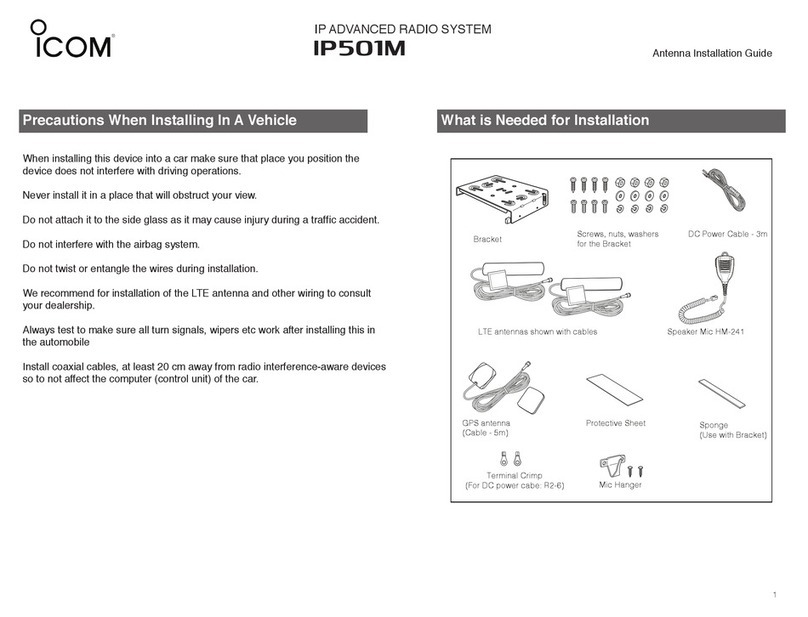
Icom
Icom IP501M User manual
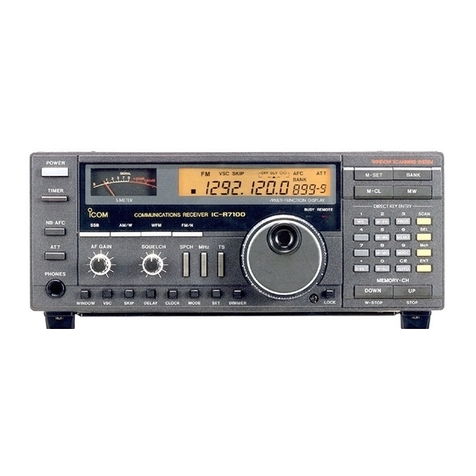
Icom
Icom IC-R7100 User manual
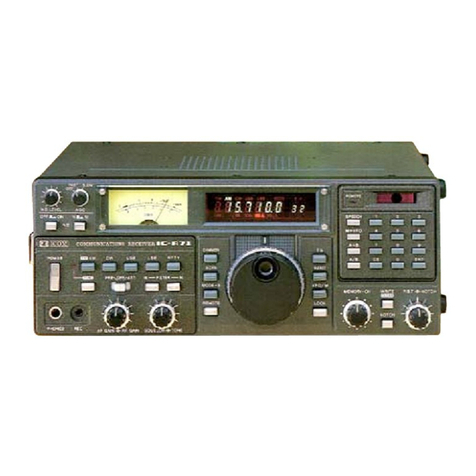
Icom
Icom IC-R71 User manual

Icom
Icom IC-R5 User manual
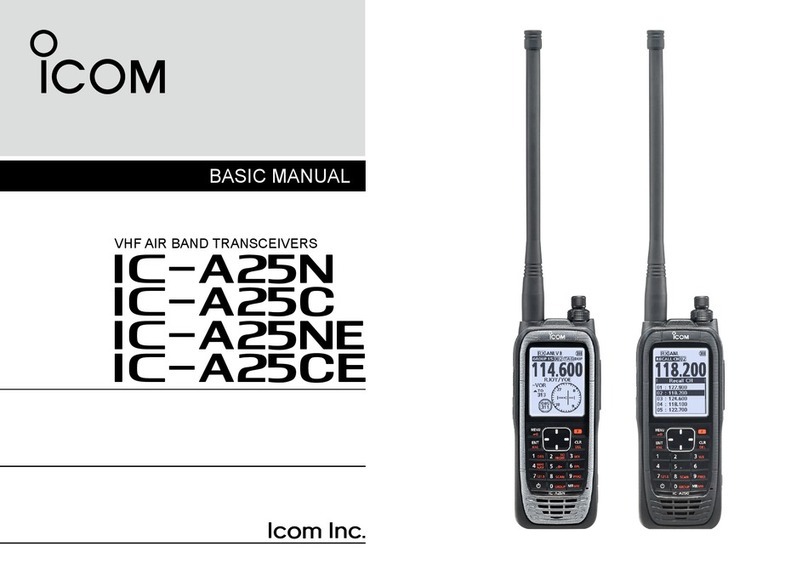
Icom
Icom IC-A25N Installation guide
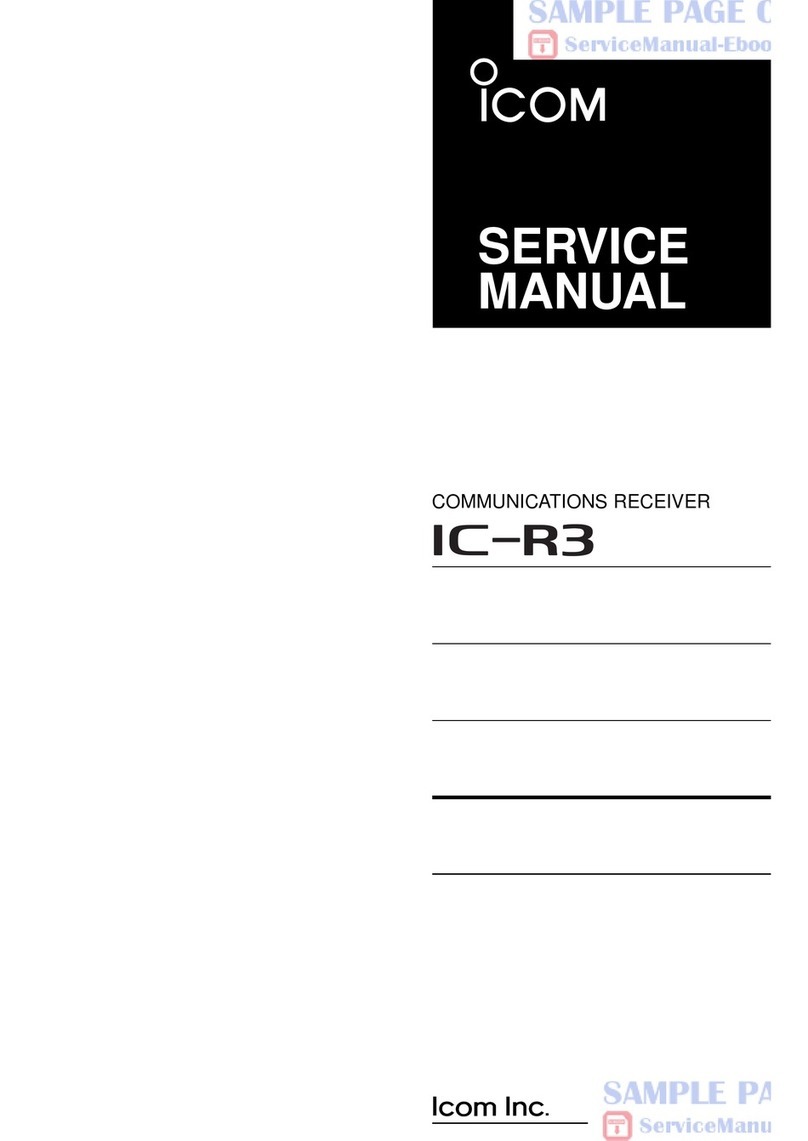
Icom
Icom COMMUNICATIONS RECEIVER IC-R3 User manual

Icom
Icom IC-R7000 User manual

Icom
Icom COMMUNICATIONS RECEIVER IC-R3 User manual
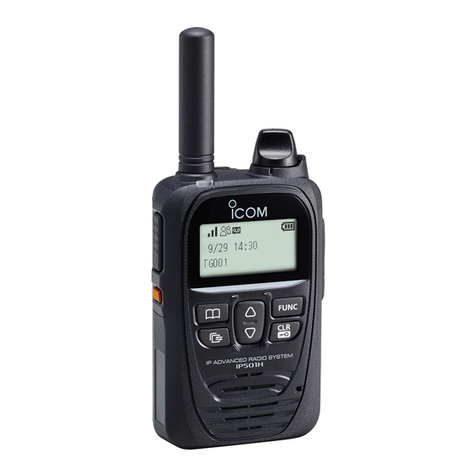
Icom
Icom IP501H User manual
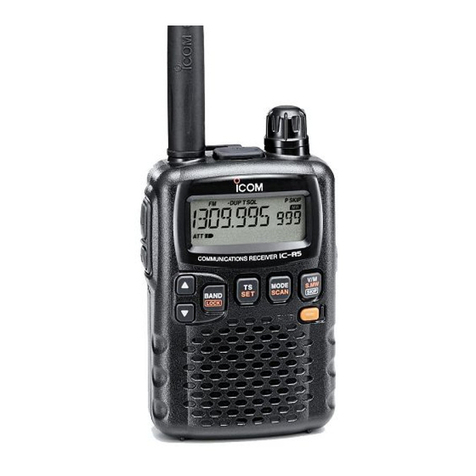
Icom
Icom IC-R5 User manual
